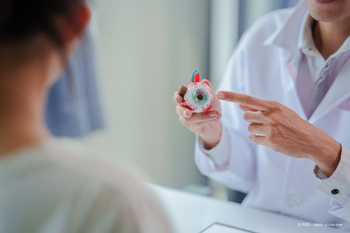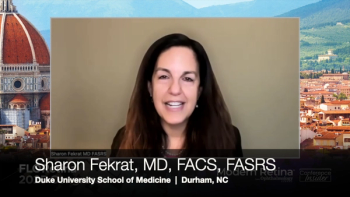
Q&A: 24-month results of the phase 2 SKYLINE trial for XLRP
The 2025 annual meeting of the American Society of Retina Specialists was held in Long Beach, California, from July 30 through August 2, 2025. At this event, Robert A. Sisk, MD, FACS, FASRS, gave a presentation titled, "Subretinal Laru-zova Gene Therapy for XLRP: 24-Month Results of the Randomized, Controlled, Multicenter Phase 2 SKYLINE Trial."
Modern Retina caught up with Sisk at the meeting to discuss these trial results and how they might impact future candidates and research into X-linked retinitis pigmentosa (XLRP).
Note: The following conversation has been lightly edited for clarity.
Modern Retina: Can you share key highlights from your presentation on the phase 2 SKYLINE trial at ASRS 2025?
Robert A. Sisk, MD, FACS, FASRS: SKYLINE was a phase 2 trial looking at the dose-dependent response of laru-zova, which is a full-length RPGR gene therapy, and trying to look at groups from the previous phase 1/2 study that showed some benefit, groups 2 and 5 from HORIZON. Ultimately, we're trying to see with a larger patient base, does that stratify out to a benefit that's greater in 1 group than the other? And we did see that in the high-dose group, there was a significant improvement in microperimetry response, which is essentially visual sensitivity in the central retina, the portion that's treated with the gene therapy, compared to the low-dose group.
MR: What patient population makes up this study?
Sisk: Males aged 8 to 50 years, who had a demonstrated pathogenic variance in the gene RPGR, which is the most common gene that causes X-linked retinitis pigmentosa, were able to participate, but they also had to have measurable microperimetry sensitivity so that they could demonstrate an increase with treatment or a decrease if there was a safety issue. And an intact foveal ellipsoid band, which is an anatomic marker that shows the integrity and health of the light-catching cells, or photoreceptors, at the area of the retina that provides the best vision?
MR: Were there any surprising or unexpected results in these data?
Sisk: Well, I think not so much from this particular study, but when we look at the HORIZON patients, it was clear that those patients who had the measurable microperimetry and the intact ellipsoid band were those who were more likely to benefit from the gene therapy. And that has been something that we've seen in a variety of other gene therapy trials. It seems like the ellipsoid zone is important. Having near-normal retinal anatomy in that area is important to see the benefit of the gene therapy.
MR: How might these results shape a phase 3 trial or future XLRP research?
Sisk: So the exciting thing is that the phase 3 [VISTA] trial is not just under way, but it's actually already fully recruited. So this trial was important in verifying the vision benefit from microperimetry. An almost parallel trial called DAWN helped to establish low luminance visual acuity is another important metric of potential visual improvement, and both of those are being looked at as primary end points for the VISTA study.
MR: Did this study provide any insights into retinitis pigmentosa as a disease state? If so, what have we learned?
Sisk: I think what we're learning is that there is, at least, with the gene therapy trials, somewhat of a narrow window in which we can treat these patients. Patients have to have some diminished vision. In the trial, it was 20/32 to 20/200. They have to have some diminished vision. Otherwise, there's a ceiling effect in terms of being able to see improvement in visual acuity. But as the visual acuity declines, there's also typically loss of the ellipsoid band. So if there's total loss of the ellipsoid band, those patients are not candidates. So from a clinical trial perspective, it's a narrow window where there's a beginning of vision decline, but not so much that it's taken away that anatomic parameter that would allow the vision to benefit. I'm hopeful that if this gets approved, following the phase 3 study, that we'll be able to treat patients at an earlier age who may be able to benefit rather than having such a narrow recruiting window.
MR: As you consider the pipeline potential therapeutics for treating patients with retinitis pigmentosa, what do you hope the future holds?
Sisk: I'm hopeful that we'll see a variety of different therapeutic options. It's very exciting to see one trial making it all the way to phase 3. But we really want patients to not just have gene augmentation therapy, but also, we want some gene agnostic approaches, like stem cell studies, optogenetic gene therapy for patients with really late-stage disease. So I think in the end, in clinical practice, we'll have therapies that harmonize and really give a more complete outcome for those patients.
Newsletter
Keep your retina practice on the forefront—subscribe for expert analysis and emerging trends in retinal disease management.













































